Summary of New Side-Impact Testing Standard for Car Seats – the good, the bad and the technical
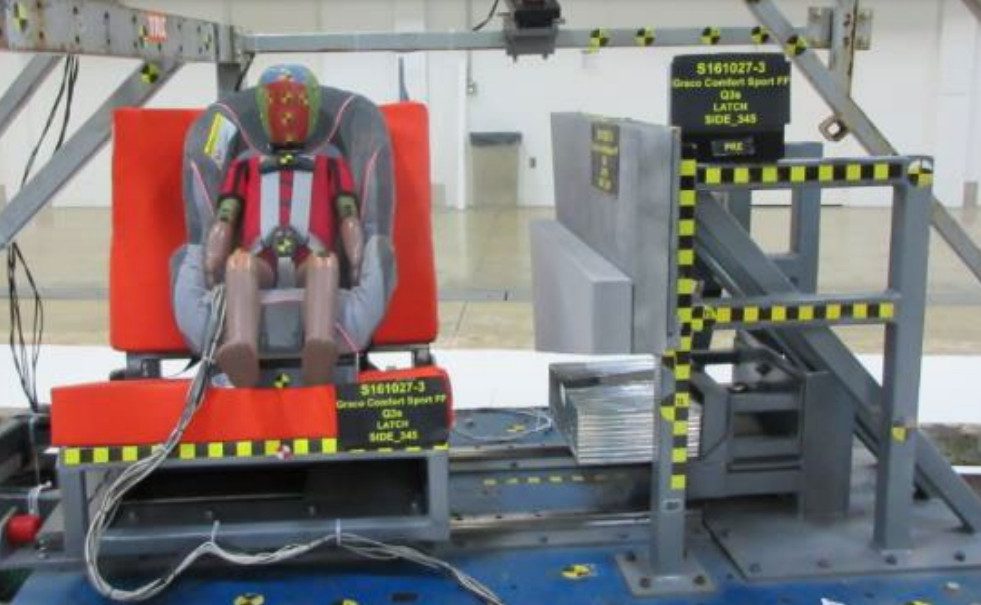
![]()
![]()
![]()
![]()
![]()
 You may have heard that NHTSA’s long-awaited Final Rule on a Federal Side-Impact Standard for car seats was finally published. Here at CarseatBlog, that was definitely an excuse to break out the bubbly since we’ve been waiting for this announcement since the summer of 2014 when the Notice of Proposed Rule Making (NPRM) was published. To be honest, we’ve actually waited over 20 years for this but I’d rather not be reminded of how quickly the last 2 decades have flown by.
You may have heard that NHTSA’s long-awaited Final Rule on a Federal Side-Impact Standard for car seats was finally published. Here at CarseatBlog, that was definitely an excuse to break out the bubbly since we’ve been waiting for this announcement since the summer of 2014 when the Notice of Proposed Rule Making (NPRM) was published. To be honest, we’ve actually waited over 20 years for this but I’d rather not be reminded of how quickly the last 2 decades have flown by.
I didn’t want to just regurgitate a press release or some bare-bones news article with no nitty-gritty details because I know you expect more than that from us. But it also took longer than I anticipated to read and absorb the 265 page document, note all my questions, chat with colleagues, and get clarification from other experts in the field.
The final rule is intriguing in so many ways but can also be really confusing if you don’t understand all the technicalities and nuances of what they’re proposing. My advice is not to get too fixated on any one thing in particular because you have to consider the whole picture. There will always be pros and cons. Almost every upside comes at the expense of something else. Everything is a tradeoff.
In writing this article I was torn over whether to keep it simple or go all out and try to help you make sense of everything. The latter seemed like an overwhelming task but I’m also not a keep-it-simple-kind-of-person. 😉
In the end, I compromised by doing a bit of both. I tried to outline the main points – the stuff that most people would care about – at the beginning of the article. Then I added details that will likely be of interest to CPSTs and child passenger safety advocates. Finally, I tossed in the stuff that only the die-hards with a serious coffee or diet-soda-induced caffeine buzz could manage to get through. I hope that pleases everyone.
Why A Federal Side-Impact Test Standard Is Important
Side-impact crashes, although less common than frontal impacts, are almost equal to frontal crashes as a source of serious and fatal injury to children 0-12. Side-impacts are especially dangerous when there are occupants seated on the struck side of the vehicle. If you are t-boned on the driver’s side of the vehicle, anyone sitting on that side of the vehicle will experience what is referred to as a “near-side impact”. Unlike frontal and rear-impact crashes, where you have a sizable chunk of the vehicle that can crumple or deform before intruding into your personal space, side-impacts are so dangerous because the only thing between you and the intruding object is the door of the vehicle and hopefully, a deployed side curtain airbag.

Not surprisingly, real-world data shows that head injuries are the most common in a side-impact crash for children 0-4 yrs old. Therefore, this new standard is potentially a big step forward in protecting our smallest passengers.
FMVSS 213a Side-Impact Standard Overview
What most parents need to take away from this is that federal government safety standards for car seats, set by the National Highway Traffic Safety Administration (NHTSA), currently have a pass/fail requirement for a frontal crash test only. This final rule will eventually add a pass/fail side-impact test that car seats with a 5-point harness must also pass in order to be sold legally in the US.
The new standard will require rear-facing and/or forward-facing car seats to restrain the dummy, manage side crash forces and prevent harmful head contact with side structures.

All car seat models that meet certain weight and height requirements will be required to comply with the new standard by June 30, 2025. This 3-year phase-in period gives child restraint manufacturers sufficient time to test, tweak, redesign or discontinue existing products, if necessary.
Early compliance with the new side-impact standard is optional and I hope that any existing car seat that can pass as-is, or with very minor adjustments, will comply quickly so the manufacturer can market their product as compliant with the new standard. However, I have no idea what the likelihood of early compliance is, or whether car seat manufacturers will even be willing to share that information once they know their product complies with all aspects of the new standard.
 It’s important to point out that booster seats, which utilize the vehicle’s lap/shoulder seatbelt to restrain the child, will NOT be required to meet this new standard, as long as the minimum child weight requirement for the booster is at least 40 lbs. and the minimum height requirement is at least 43.3” tall.
It’s important to point out that booster seats, which utilize the vehicle’s lap/shoulder seatbelt to restrain the child, will NOT be required to meet this new standard, as long as the minimum child weight requirement for the booster is at least 40 lbs. and the minimum height requirement is at least 43.3” tall.
Most booster seats made in the last 1-2 years already have a minimum weight rating of 40 lbs. This new requirement will pretty much guarantee that all booster seats will have a starting weight limit of at least 40 lbs. and a minimum height requirement of at least 43.3” by the time compliance with the new standard is required in 2025. If you’re wondering why they decided on 43.3 inches as the threshold for minimum booster height – it correlates to 1100 mm or 110 cm.
While it might seem like a cop-out to exclude booster seats, it’s not really. It would be difficult for most booster seat designs to meet the side-impact standard using just a 3-point lap/shoulder seatbelt. A 3-point restraint system just doesn’t provide the same level of containment that a 5-point harness provides. Plus, kids who weigh more than 40 lbs. and are taller than 43” are generally tall enough to take advantage of the side-curtain airbags in most modern vehicles when elevated by a few inches because they are sitting on a booster. By using a booster seat which “boosts” an older child who has outgrown their car seat with a 5-point harness, the child can be afforded the same side-impact protection that the vehicle offers to an adult-sized occupant.
For smaller/younger children, it is generally accepted that children who weigh less than 40 lbs. are better protected by a car seat with a 5-point harness. Also, children who weigh more than 40 lbs. but are not tall enough to take advantage of the vehicle’s side-curtain airbags (even when sitting in a booster seat), or not mature enough to stay properly seated in a booster, should also continue to use an appropriate car seat with a 5-point harness.
This “exemption” for booster seats will also apply to any car seat that features a “booster mode”. The car seat will be side-impact tested using its internal 5-point harness but in booster mode it will be exempt from having to pass the same standard – as long as the manufacturer states that the minimum weight and height to use the product in booster mode is at least 40 lbs. and 43.3”.

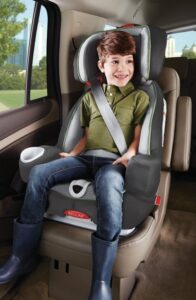
Side-Impact Test Details
This new side-impact crash test will simulate a small car (e.g., a Nissan Sentra) moving through an intersection at a low speed and being “T-boned” by another car. This is very similar to how actual vehicles are crash tested to comply with a different federal safety standard for side-impact, FMVSS 214.
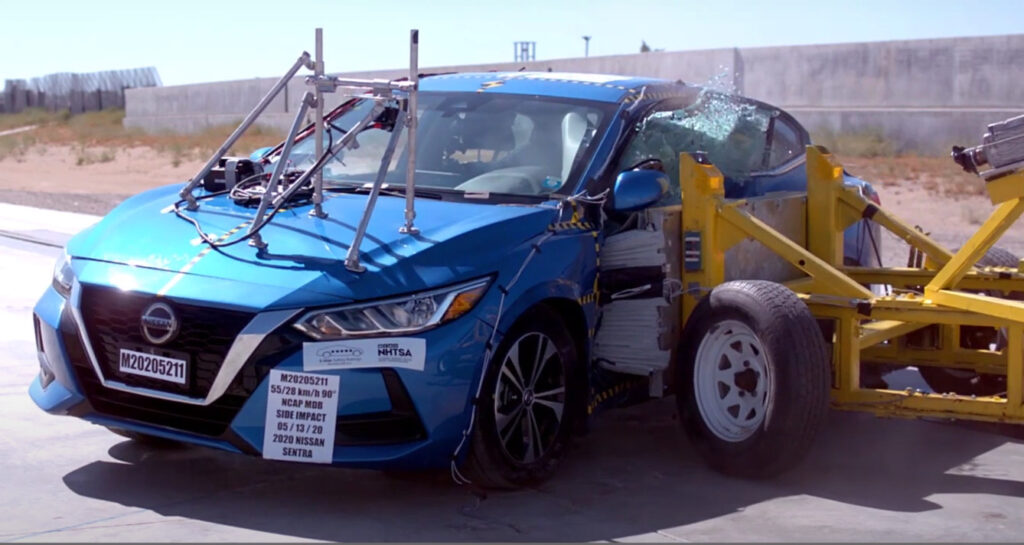
In this new side-impact simulation, a properly installed car seat will be secured to a unique test sled designed solely for this purpose. The 12-month-old or 3-year-old test dummy (depending on the weight rating of the car seat) will be properly harnessed in the car seat. The car seat will then be impacted by a simulated intruding door structure. The “intrusion” element of the test is very important since we know intrusion is a major factor in causing injuries in real world side-impact crashes. The entire event will be recorded on high speed film and the results will be evaluated for certain criteria. This criteria will vary based on the capabilities of the dummy used in the test.

Please note that this will NOT be a 5-star comparative type of rating for crash safety. This will be a pass/fail test and any car seat that doesn’t pass the performance requirements of the new standard once compliance is mandatory in 2025, will be subject to recall.
What About the Car Seat You Already Own, Or Are Planning to Buy?
For everyone who already owns a car seat or is planning to buy a new one before June 30, 2025: Unfortunately, there is just no way to know whether the model you already own or are planning to buy in the near future would be able to pass this new side-impact standard without modifications. NHTSA specifically allowed a 3-year period before car seats were required to comply. They understood that manufacturers needed sufficient time to become familiar with the new test procedures and the Q3s dummy, assess their products ability to pass the new performance requirements, and to make changes if necessary.
While this whole process of compliance could take 2-3 years, I feel confident in saying that at least some car seat models will be able to pass either as-is or with minor modifications. We won’t know which models these are until we start to see manufacturers promoting adherence to this new standard but hopefully we will start to see acknowledgement of early compliance sooner rather than later.
If you are concerned about the ability of your current car seat to protect your child in a severe side-impact crash, take some comfort in knowing that side-impact protection has been a priority for most major car seat manufacturers for over a decade. Every major child restraint manufacturer (Britax, Chicco, Clek, Cybex, Dorel, Evenflo, Graco, Nuna, UPPAbaby, etc.) already has some sort of proprietary side-impact testing standard although it’s probably different from this new federal standard. To their credit, car seat manufacturers have been designing new products with side-impact protection in mind for years. This new standard will just get everyone on the same page.
More Details on the Final Rule for CPS Techs and Advocates
NHTSA designed this final rule to work within the framework of the existing frontal standard.
“This final rule amends Federal Motor Vehicle Safety Standard (FMVSS) (Standard) No. 213, “Child restraint systems,” and adds FMVSS No. 213a, which is referenced by Standard No. 213. This final rule fulfills a statutory mandate set forth in the “Moving Ahead for Progress in the 21st Century Act” (MAP-21) that directed the Secretary of Transportation (NHTSA by delegation) to issue a final rule to improve the protection of children seated in child restraint systems during side impacts.”
The finalized test procedure would simulate the full-scale vehicle-to-vehicle side-impact crash replicated by FMVSS 214.
Dynamic sled test will simulate the change in velocity of the MDB (Movable Deformable Barrier) test of FMVSS 214 which simulates the striking vehicle traveling at 30 mph (48.3 km/h) impacting the struck vehicle traveling at 15 mph (24 km/h).
Tests Child Restraint Systems (CRS) in near-side impact
First test of its kind in the world for testing CRS in a sled system that simulates both vehicle acceleration and intruding door of a small passenger car
Door intrusion known to be a factor for moderate and severe injury in side impacts
Test sled based on a modified acceleration sled system developed by Takata
Test Dummies (ATDs)
CRABI: 12-month-old dummy used in frontal crash testing (22 lbs., 29” tall)
Q3s: The side-impact version of the 3-yr-old Q Series dummy developed in Europe (32 lbs., 38.5” tall)
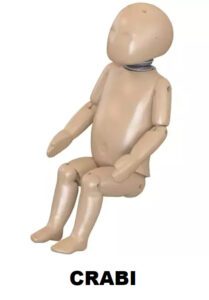
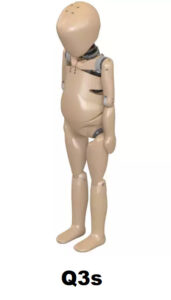
ATD Selection Criteria
The final rule specifies which ATDs will be used to test different car seats.
CRS rated for a child weight of anywhere between 11 to 30 lbs. or with a stated height limit of anywhere between 25.5 – 34.3” (650 – 870 mm) will be tested with CRABI. This means any seat with a weight range of 4-30 lbs. or 5-22 lbs. or something unusual like 12-25 lbs., will be tested using just CRABI.
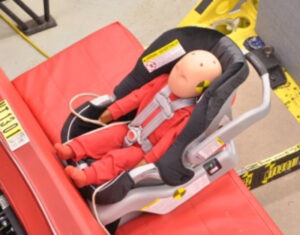
Any infant seat (RFO) rated to a weight limit beyond 30 lbs. (after June 2025) would be required to fit the Q3s and pass performance requirements with that larger ATD. It is likely that most infant car seats that currently have a 35 lb. weight limit will backtrack to 30 lbs. to avoid testing with the larger ATD that probably doesn’t fit in the seat anyway.
CRS rated to include a weight range anywhere between 30-40 lbs., (including boosters and infant seats if applicable) or with a stated height limit of anywhere between 34.3 – 43.3” (870 – 1100 mm) will be tested with Q3s dummy. This means any car seat rated from 4-65 lbs., or from 22-50 lbs., or from 30-65 lbs., will be required to pass standards with Q3s.

Booster seats would also be required to test and pass with Q3s, if they had a weight rating below 40 lbs. At some point before compliance becomes mandatory, booster seats will probably all start at 40 lbs. (or more) and 43.3” tall (or more) to avoid having to test and pass the side-impact standard altogether.
All current convertible and All-in-One car seats will have to pass the side-impact performance requirements with the Q3s, both rear-facing and forward-facing, unless the manufacturer decides to discontinue production of that car seat model prior to June 30, 2025.
Installation Methods for 213a Testing
Rear-facing CRS installed using lower anchors
Rear-facing CRS installed using 3-pt lap/shoulder seatbelt
Forward-facing CRS installed with LATCH (lower anchors and tether)
Forward-facing CRS installed with 3-pt lap/shoulder seatbelt and tether

Performance Requirements
CRABI:
Test for containment by evaluating whether or not there was head-to-door contact. If the dummy’s head fails to be completely contained by the car seat and makes contact with the door, that is an automatic failure. There are also some specific “structural integrity” requirements that the CRS must pass.
Q3s: Must not exceed HIC and chest deflection limits
HIC15 ≤ 570
Chest Deflection ≤ 23 mm
Also must pass specific “structural integrity” requirements
Positioning of CRS on SISA:
Center of CRS positioned 300mm (11.8 inches) from edge of the sliding seat next to the intruding door – simulating a near-side seating position
Rationale for limiting testing to under 40 lbs.
No appropriate test dummy for representing kids over 40 lbs. right now.
According to 2011 NCRUSS Study, only 8% of 6-year-olds were restrained in a harnessed car seat.
NHTSA determined that seated height of children over 40 lbs., when sitting on a booster, is typically sufficient to take advantage of the vehicle’s side impact protection system (including curtain airbags).
Limitations of Standard
Limited dummy sizes restrict the applicability of the standard to children under 40 lbs.
Due in part to the lack of appropriate larger side-impact test dummies, this new standard only tests with dummies that are the size of a 12-month-old and a 3-year-old. The weight rating of the car seat will determine which of these 2 ATDs will be used in the test. Additionally, of those 2 ATDs, only the Q3s is instrumented in a way that can provide meaningful data that correlate to potential injury risks in a side-impact crash. The 12-month size dummy can only be used to assess “containment” in the side-impact test.
Infant car seats, which are portable and typically compatible with a stroller, will likely only be tested with the 12-month-old dummy known as “CRABI”. The 3-year-old test dummy doesn’t fit in the vast majority of current infant car seats, in the same way that most 3-year-old children have long outgrown their infant seats by height, even if they still weigh less than the stated weight limit of the infant seat.
However, since CRABI is a frontal crash test dummy which isn’t instrumented to register side-impact forces, infant seats cannot be evaluated in the same meaningful way that larger car seats, subject to testing with the Q3s dummy, will be evaluated. While CRABI is not a side-impact dummy, NHTSA decided that it could be useful to evaluate some aspects of CRS performance in a side-impact crash.
There is no head containment requirement for testing with Q3s. Head contact with the simulated door or beltline (aka, windowsill structure) will NOT result in an automatic failure the way it would with any 213a side-impact compliance test utilizing CRABI. Instead, the HIC15 criterion will evaluate whether an impact is injurious or not.
Combination or All-in-One seats with harness rated to 40 or 50 lbs. may be outgrown by weight while child is still under the height minimum of 43.3”.
Positive Impacts of Standard
213a test simulates real-world SI crash better than other existing sled tests
We will finally be testing CRS with a 3-point seatbelt
Enhanced SIP on most convertibles and combination seats will benefit taller/heavier children as well
All boosters (likely) will start at 40 lbs.
All CRS Manufacturers on the same page, testing to the same standard
How will car seats adapt to pass the new standards?
Internal testing by NHTSA in 2017 indicated that placement of coverage, materials, internal structures, shape of the coverage and other factors must be purposefully engineered. Just adding thicker foam, deeper side wings, etc., is not necessarily better. There are optimal ways to add structure and padding. Simply adding more “bulk” can actually have adverse effects on the performance of the CRS in the side-impact test.
Most readers can stop here unless they are looking to cure their insomnia. Geeks and die-hard advocates looking for in-depth commentary are warned that it’s about to get technical!
~~~~~~~~~~~~~~~~~~~~~~~~~~~~~~~~~~~~~~~~~~
Simulating a Real-World SI Crash
NHTSA tentatively concludes that a side impact is best replicated if the test procedure reflects and replicates dynamic elements of both the striking and struck vehicle in a vehicle-to-vehicle crash.
“We believe that a side-impact test procedure should account for: (1) the struck vehicle door velocity prior to the interaction of the striking vehicle with the door sill of the struck vehicle, (2) the acceleration profile of the struck vehicle, and (3) the impact angle to replicate the longitudinal component of the direction of force. Specification of these parameters, based on actual vehicle crash characteristics, would enable the realistic simulation of the relative velocity between the intruding door and the CRS.”
The final SISA test buck consists of a sliding “vehicle” seat (representative of a rear seat designated seating position) mounted to a rail system along with a “side door” structure rigidly mounted to the sled buck structure. The sliding “vehicle” seat and side door are representative of a typical modern passenger vehicle. This “Side Impact Seat Assembly” (SISA) is positioned sufficiently away from the side door to allow the sled to reach the desired velocity (31.3 km/h) prior to the time the sliding “vehicle” seat starts to accelerate to a specific acceleration profile.
Based on tests and on average impact angle computed from the vehicle’s right rear sill velocities of MDB-to-vehicle crash tests, NHTSA selected a 10-degree impact angle as the most appropriate.
NHTSA also conducted sled tests at different impact angles (0, 5, 10, and 20 degrees) using the Takata sled procedure to compare them to four MDB crash tests performed using the Q3s dummy restrained in a CRS in the rear seat behind the driver. They found that a 10-degree impact angle on the sled test produced dummy responses closer to those measured by the ATD in the same CRS in the four MDB crash tests than the other impact angles.
Test bench, door geometry, vehicle seat and door padding characteristics are important in a side impact test, to ensure these are representative of the vehicle rear seat environment. NHTSA identified the following rear seat features to replicate in the SISA: rear seat geometry, rear seat cushion stiffness, and door shape (height of window, armrest thickness, door padding).
Additional Info on Q3s
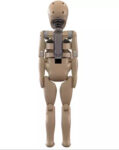 Q3s is built on the platform of the standard Q3 dummy series (the Q-series are frontal ATDs used in Europe), but the Q3s has enhanced lateral biofidelity, durability, and additional instrumentation for specialized use in side impact testing. For instrumentation, the Q3s has three uni-axial accelerometers at the head center of gravity and an InfraRed Telescoping Rod for Assessment of Chest Compression in the thorax for measuring lateral chest deflection. The Q3s also has a deformable shoulder with shoulder deflection measurement capabilities, arms with improved flesh characteristics, a laterally compliant chest, and a pelvis with improved upper leg flesh, floating hip cups, and a pubic load transducer.
Q3s is built on the platform of the standard Q3 dummy series (the Q-series are frontal ATDs used in Europe), but the Q3s has enhanced lateral biofidelity, durability, and additional instrumentation for specialized use in side impact testing. For instrumentation, the Q3s has three uni-axial accelerometers at the head center of gravity and an InfraRed Telescoping Rod for Assessment of Chest Compression in the thorax for measuring lateral chest deflection. The Q3s also has a deformable shoulder with shoulder deflection measurement capabilities, arms with improved flesh characteristics, a laterally compliant chest, and a pelvis with improved upper leg flesh, floating hip cups, and a pubic load transducer.
Specifications for the Q3s were adopted into NHTSA’s regulation for anthropomorphic test devices (49 CFR part 572) on November 3, 2020.
Finalized Injury Criteria
There is no infant test dummy available that is specially designed for side-impact testing. While the CRABI dummy is not a side impact dummy, NHTSA believes that it could be a useful tool to evaluate some aspects of CR performance in side-impacts. Even if the evaluation is limited to containment, structural integrity, and other related matters. CRABI will be used to measure head-to-door contact only, not HIC15 or chest acceleration.
Q3s Injury Criteria
HIC15 ≤ 570
FMVSS No. 213’s frontal impact requirement specifies an injury assessment reference value (IARV) of 1,000 measured in a 36 ms timeframe (HIC36=1,000). However, for the side-impact 213a requirement, NHTSA has implemented a HIC limit of 570 measured in a 15 ms timeframe (HIC15=570) when using the Q3s.
In the 213a side-impact test, the test environment is set up so that ATD head contact with the CRS and also with the door is probable. Injurious contacts (such as head-to-door contacts) are of short duration (less than 15 ms) and are more appropriately addressed by HIC15 than HIC36.
NHTSA believes that there is no need for a Q3s performance criterion that would prohibit head contact with the intruding door. Video analysis suggested that the peak head acceleration was most likely the result of the Q3s head contacting the side of the CRS at the time the CRS contacted the intruding door. Given that the head acceleration values computed during the time of head-to-door contact were lower than the peak head acceleration, NHTSA believes that the risk of head injury from head-to-door contacts were much lower than the risk of head injury from the peak acceleration. For these reasons, NHTSA has decided not to use a performance criterion based on head contact in tests with the Q3s dummy because HIC15 appears better able to discern between “soft” non-injurious contacts and “hard” injurious contacts, and thus would be a better predictor of head injury in the side impact test.
However, NHTSA believes that CRABI would be suitable and should be used for assessing safety risks related to a CR’s ability to limit head-to-door contact in side-impact crashes. CRABI can provide a worst-case assessment of injury risk in a side impact in terms of head-to-door contact. If the CRS were unable to prevent the ATD’s head from contacting the door in the test, NHTSA believes such an outcome would be a reasonable indication of an unacceptable risk of head contact of children represented by the CRABI.
Therefore, NHTSA has finalized head-to-door contact as a pass-fail criterion for assessing CRS tested with CRABI. NHTSA believes this criterion will lead to improved side coverage in CRS designed for children less than 30 lbs.
Chest Deflection ≤ 23 mm
Final rule implements a chest displacement IARV for the Q3s of 23 mm based on two separate studies that used length-based scaling from adult post-mortem human subject and dummy responses to generate an estimated injury risk for a 3-year-old child. The studies both found, based on their independent data sets, that a displacement of 23 mm represented a 30 percent and 33 percent probability of AIS 3+ injury, respectively.
Structural Integrity
The CRS will also be evaluated for its ability to maintain “system integrity” when tested with either the Q3s or CRABI. When a CRS is dynamically tested with the appropriate ATD, there cannot be any complete separation of any load-bearing structural element of the CRS or any partial separation that exposes surfaces with sharp edges that may contact an occupant.
Exemptions
Harnesses (Vests)
Harnesses (vests) will be excluded because of practicability concerns about the ability of the harness to meet the proposed requirements and because harnesses serve a need in certain populations. Harnesses would likely not be able to meet the proposed performance requirements because they do not have a side structure that can be reinforced and/or padded to mitigate forces on the Q3s in the side test. At the same time, we recognize that there is a niche served by harnesses on some school buses and in certain special needs transportation, one whose needs cannot be met by any other type of CRS. In addition, the side-impact crash environment of a school bus is significantly different from that simulated by the proposed sled test procedure (which simulates a near-side impact of a small passenger car). Accordingly, NHTSA is excluding harnesses from the proposed side-impact requirements.
Car Beds
Car beds are also excluded from the requirements. Car beds do not “seat” children but instead restrain or position a child in a supine or prone position on a continuous flat surface. FMVSS No. 213 requires manufacturers of car beds to provide instructions stating that the car bed should be positioned in the vehicle such that the child’s head is near the center of the vehicle. NHTSA believes that, due to the supine position and location of the head of the child, the risk of injury and the injury patterns of children in car beds are much different from those of children seated forward- or rear-facing. There is no accident data available that show that benefits would accrue from applying the proposed side impact protection standard to car beds.
If you’ve made it this far, congratulations! You have an attention span greater than 99.8% of humans on this planet. Unfortunately, you may also be among the .2% of the population whose insomnia cannot be cured by FMVSS 213a. Have you tried warm milk?






